


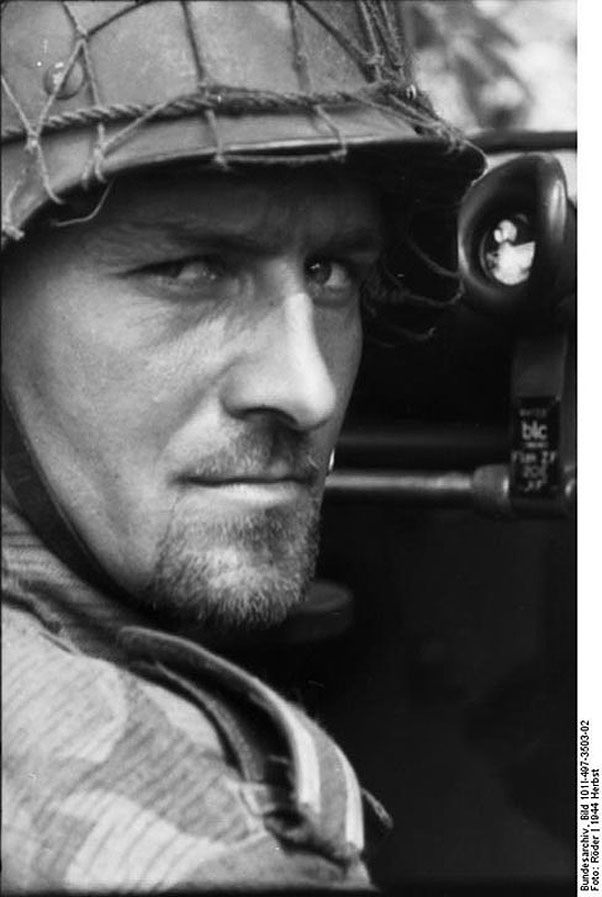




Although animals fought beside every army in some capacity in WWII, with the German army they were truly protected and cherished. Never were animals and creatures of all kinds more safeguarded. It was the first time in human history animals were granted rights and a protected status.
National Socialism sought to live and work in harmony with nature and all of her creations.
As Savitri Devi said -- 'animals are National Socialists.' Mother Nature is the most fervent, radical National Socialist of them all.

[Above: Adolf Hitler and one of his loyal and constant companions. Adolf Hitler deeply loved animals.]
[Above: Animals saluting Göring - The poster declares 'Heil Göring' and 'Vivisection forbidden'. It appeared in 'Kladderadatsch', September 3, 1933.]
[Above: A Dutch Göring letting loose lab animals while picking up the vivisectionist by his collar. The top says 'Göring verbiedt vivisectie (op dieren)'
[Above: Hermann Göring's lion cub Mucki.]
'An absolute and permanent ban on vivisection is not only a necessary law to protect animals and to show sympathy with their pain, but it is also a law for humanity itself… I have therefore announced the immediate prohibition of vivisection and have made the practice a punishable offense in Prussia. Until such time as punishment is pronounced the culprit shall be lodged in a concentration camp.'
[Above: A kitten plays in a dreaded Waffen-SS helmet.]
[Above: Two comrades.]
[Above: A puppy catches a free ride from a German automobile.]
*As of 2021 the inhuman practice of vivisection was perfectly legal in the United States. The American Anti-Vivisection Society is still operating, but little has been done to stop the pervasive practice.
[Above: There is resistance to the evil practice of vivisection. Here are two postal labels promoting anti-vivisection.]
[Above: Here is an old British anti-vivisection poster. Vivisection has been going on for a long, long time.]
*This section is dedicated to the two noble spirits, Zobeida Khatun and Savitri Devi.
[Above: Boris Shiryaev, a communist arrest photo. It looks as if he as been through hell and back. Like a wise old sage from a magical time.]
At Moscow State University Shiryaev studied history and philology (the study of languages, their historical development, linguistics and relationships to other languages). At the university he was also engaged in teaching and theater.
Eventually his quest for knowledge took him to the University of Göttingen, Germany. After returning to Russia, he joined the military where he graduated from the General Staff Academy.
During the First World War, he reached the rank of captain in the army. In 1918 he returned to Moscow and attempted to join the Volunteer Army, but was arrested and sentenced by the Bolsheviks to death for trying to cross the border.
[Above: Volunteer Army recruitment poster. The imagery here is a mother addressing her son with the words: 'My son! Go and save your Motherland!'.]
[Above: Volunteer Army recruitment poster.]
In 1925-26 Shiryaev managed to publish the novel '1237 lines' and several poems: 'Solovki', 'The Dialectics of Today', 'Turkestan poems' and several others. Shiryaev also collected and recorded camp folklore, which was published in brochure form with a circulation of 2000 copies.
In 1929 he was moved to Central Asia, where Shiryaev spent time as a journalist. In 1932 he finally returned to Moscow, only to be arrested again and sent to 3 years to Rossosh village (Voronezh Oblast).
[Above: 'White Movement' propaganda poster from the Russian Civil War (1919). It depicts a caricature of Leon Trotsky as a red devil and below him invading Chinese soldiers on mountains of Russian skulls.]
[Above: Another poster showing the forces of life versus that of death.]
On August 3, 1942 German and Romanian troops occupied Stavropol. Shiryaev finally had the opportunity to fight the communist monsters which had tortured his existence for so many years. He worked for the newspaper 'Stavropol Word'. The first issue was small, just four pages, and dealt primarily with news from the battle front. It was decisively anti-communist.
After four months the newspaper was renamed the 'Morning of the Caucasus' and had a circulation spread across the North Caucasus region.
During the German/Axis retreat Shiryaev left Stavropol with the Germans. In May 1943 he attended school in Dabendorf ROA (at Berlin). He worked on another newspaper for the Crimea called 'Voice of the Crimea'. In June 1943, in Simferopol the German High Command recognized his contributions in the fight against communism and awarded him a decoration.
[Above: Another Russian Civil War poster featuring Leon Trotsky. Death whispers in his ear while he clutches a bloody dagger and sits on a sea of skulls. In the distance Russia burns while his minions murder and drag off bodies. The posters were eerily prophetic.]
After the communist victory of WWII he ended up in a camp for displaced persons in Capua, Italy. He would later write about his experiences there in the book 'Pee Dee in Italy', which was published in Russian in Buenos Aires in 1952. 'Pee Dee' comes from the Russian abbreviation of 'displaced persons'. 'Displaced persons' was the name given to the millions of people who had their homes destroyed by the Allied bombing campaign, which ruthlessly targeted civilians, and the floods of refugees fleeing the communists.
In Italy Boris Shiryaev continued writing books and literary articles. He was published in various Russian magazines like 'Rebirth' and 'The Edge'.
[Above: Boris Shiryaev.]
Shiryaev's first three books - 'Pee Dee in Italy' (1952), 'I'm a Russian' (1953) and 'Lights of the Russian Land' (1953) were all published in Buenos Aires, with the assistance of an associate who lived in Argentina. It's worth noting that Ivan Solonevich, his publisher, had a brother, Boris Solonevich, who was also in a prison camp with Shiryaev.
He continued his written works in the years that followed: 'The Last Gentleman' (1954), 'To the Intellectuals of the Soviet Union' (1955) 'Kudeyarov Oak' (1958) and 'Religious Motifs in Russian Poetry' (1962).
[Above: The Inextinguishable Lamp, in Russian, still in print, as of 2021.]
[Above: Russian Volunteer Army recruitment poster.]
'If the world hates you, keep in mind that it hated me first.'
[Above: 'God is with Us'. This is the front piece of a German army police belt buckle. The German army wore a similiar belt buckle with an eagle holding a swastika. The buckle was worn by millions of German troops. These same soldiers took a solemn oath which began:
[Above: The man of the 20th century, of all centuries, Adolf Hitler.]
'At the very time when America's allies, the Soviets,
[Above: Adolf Hitler standing before the graves of his parents, Alois and Klara Hitler. Click to see more.]
And very telling of the National Socialists feeling toward Christianity is the German National Socialist '25-point program'. Number 24 specifically:
[Above: A young Adolf Hitler may have first seen the swastika at the Benedictine monastery where he served as an altar boy. Each time he entered the monastery he passed beneath the ancient swastika carved in stone on an arch above the entrance of the abbey.]
The great soldier and writer Léon Degrelle, in his splendid book on Adolf Hitler called 'Hitler Democrat', describes the Führer in a spiritual light:
'He had a deep knowledge and understanding of Buddha, Confucius and Jesus Christ, as well as Luther, Calvin or Savonarola...'
[page 25]
And further:
'Did Hitler believe in God?
[Above: Wow, this looks so neat. Note the swastika ribbon on the wreath.]
[Above: A 1939 official German census revealed a whopping 94% of Germans were Christians and only 1.5% 'irreligious' ('Gottgläubig' means belief in God).]
[Above: An envelope from the Vatican commemorating the birthday of Benito Mussolini, July 29, 1936. Click on the image to see other interesting postal material from the Vatican.]
On March 24, 1933 the Catholic Church supported 'The Enabling Act of 1933', which gave the German Cabinet the power to enact laws without the involvement of the Reichstag. The Act was temporary as it had to be voted on after four years to be renewed.
[Above: An early National Socialist election poster with Christian imagery.]
'By its decision to carry out the political and moral cleansing of our public life,
The Government will treat all other denominations with objective and impartial
The struggle against the materialistic ideology and for the erection of a true
[Above: Pope XI signing the Concordat between the Vatican and National Socialist Germany, July 20, 1933.]
Here is a translation of Article 16 of the Reichskonkordat:
'Article 16
Before bishops take possession of their dioceses they are to take an oath of fealty
"Before God and on the Holy Gospels I swear and promise as I become a bishop,
On March 12, 1933, the German Cardinal Faulhaber was received by Pope Pius XI in Rome. When he returned he said:
'After my recent experience in Rome in the highest circles, which I cannot
[Above: Cardinal Michael von Faulhaber (March 5, 1869 – June 12, 1952). He is seen here taking part in a National Socialist parade.]
'Catholics admire Herr Hitler as a hero...'
[Above: Catholic Archbishop Stepinac (May 8, 1898 – February 10, 1960) meeting with Croatian leader Ante Pavelic.]
[Above: A period postcard showing Jews and Masons (note the Masonic apron on the guy on the right) attacking Christ. There was an exhibition at the Erlangen Masonic lodge, described as 'The only lodge in the world open to public exhibition'. After the National Socialists closed down and banned Masonry in Germany, some of the lodges, like this one, were opened up to the public, showing all sorts of dark occult paraphernalia.]
[Ivan Šaric (September 27, 1871 – July 16, 1960) was a Roman Catholic priest who became the archbishop of the Roman Catholic Archdiocese of Vrhbosna (Sarajevo) in 1922. In 1940 Šaric was tasked by the National Bishops Conference to create the first modern Croatian translation of the Bible. He was a fiery supporter of the Ustaše in words and deeds. ]
'Until now God spoke through papal encyclicals, sermons, the Christian press...
'The descendants of those who hated Jesus, who condemned him to death,
[Above: Ante Pavelic surrounded by Franciscan monks.]
[Above:
'These Atrocities: Your Fault!'
One of many propaganda posters distributed by American occupation authorities in the summer of 1945. These tactics instilled deep guilt in the German population. They often used pictures of GERMAN corpses killed in Allied air raids or GERMAN prisoners that had died from starvation and the elements in Allied concentration camps, and labeled them JEWS. They bombed German civilian targets all over Germany, even when they learned there were Allied P.O.W.s there --they didn't care. What good were captured puppet-soldiers? Stalin believed that any captured Russian was automatically a traitor. When his own son was captured by the Germans and the Germans requested to trade him for German prisoners Stalin said no, he's a traitor because he got captured! When the Allies strategically bombed railroad lines that led to concentration camps to oblivion the end result was mass starvation. When typhus broke out in some of the camps the German guards had no way to control it and an epidemic ensued. The prisoners and the guards were trapped in hell, no way in, no way out. Yet the sadistic Allies blamed the Germans for these deaths and called it the greatest 'holocaust' of all time. Well, if it was a holocaust, the Allies were responsible.]
[Above: Alois Hudal (May 31, 1885 – May 13, 1963) was an Austrian titular bishop (a bishop who is not in charge of a diocese) in the Roman Catholic church, based in Rome. He was an influential representative of the Austrian Catholic Church. In his 1937 book, 'The Foundations of National Socialism', he praised Adolf Hitler and National Socialism and indirectly attacked Vatican policies. He was a committed anti-communist and opposed Liberalism. After WWII he was instrumental in establishing escape lines which allowed Germans and other Axis soldiers, officers and political leaders, many of them accused 'war criminals', to escape Allied trials and 'denazification'. Hudal helped thousands of men and women escape dungeons and death.]
Ante Pavelic, the leader of Croatia, was allowed to stay in the Vatican disguised as a Catholic priest. While there he became good friends with the aforementioned future Pope, Monsignor Montini. The Monsignor was the Vatican's Under Secretary of State at the time. Pavelic escaped to Buenos Aires, Argentina by November of 1947, where an entourage of Catholic priests met him. When Pavelic died in 1959 a personal benediction was proclaimed upon him by Pope John XXIII. The Vatican also arranged the escapes of Adolf Eichmann, Klaus Barbie, Josef Mengele and tens of thousands of National Socialists and their allies.
'Adolf Hitler, son of the Catholic Church, died while defending Christianity.
[Above: Francisco Franco (December 4, 1892 – November 20, 1975) was a Spanish general and the dictator of Spain. In the 1920s he was the youngest general in Europe.]
[Above: While Franco never officially joined the Axis, Spain did send a division of Spanish volunteers to help fight communism on the Eastern Front.]
[Above: A collage with Franco in the center.]
[Above: Otto Skorzeny (June 12, 1908 – July 5, 1975) was the greatest commando of all time. His feats during WWII are the stuff of legends. Before rescuing Mussolini, Adolf Hitler uttered the words to him that are now legend: 'I know the time given to you is very short, but I count on you to do the impossible...'!]
[Above: Léon Degrelle (June 15, 1906 – March 31, 1994) was one of the true greats of WWII and human history.]
[Above: This five mark coin shows the famous Potsdam Church. It celebrates the opening of the Reichstag -- March 21, 1933, known as 'The Day of Potsdam'. This coin commemorates the one year anniversary of the event. It was minted in 1934 and 1935. It was struck in two denominations; two and five marks. It is .900 silver.]
[Above: St. Michael, legendary Christian slayer of evil, grasps the flag draped shoulder of a National Socialist stormtrooper, as they prepare to slay the Judeo-hydra-beast together.]
[Above: This postcard, also bearing the image of St. Michael slaying the dragon, is from 1934/35 and was for the Winter Relief Organization of the German Peoples (WHW).
_________________________________________
Deutsche Christen (German Christian)
[Above: German Christians membership badge.]
[Above: German Christians' membership card from 1933. Their ultimate membership was 600,000.]
[Above: Pin of the German Christians (Deutsche Christen) party.]
[Above: Book cover of 'German Christian' (Deutsche Christen).]
[Above: Close-up.]
In September the Deutsche Christen party's leader Ludwig Müller became the leader of this merged group of Protestants, he was called the Reichsbischof ('Reich bishop').
'Just like for all peoples, the eternal God has for our people also created a characteristic tenet/law.
[Above: Ludwig Müller (June 23, 1883 – July 31, 1945) was leader of the German Christians party which promoted 'positive Christianity'. He remained committed to National Socialism and Adolf Hitler to the very end. He committed suicide in Berlin in July 1945, shortly after the darkness had won and everything that he knew to be good was in ruins. Ludwig Müller, an 'Old Fighter' till the end!]
'One People! – One God! – One Reich! – One Church!'
'To us now is risen the incarnation of what Christianity really is: Adolf Hitler.'
[Above: German Christians Students' Fighting League at a rally in Opernplatz in Berlin. Note the distinct flag representing this youth organization within the German Christians.]
[Above: Ludwig Müller wearing his WWI medal bar]
[Above: Flyer for the German Christians rally on October 16, 1934.]
'We, as National Socialist fighters, are committed to not end a fight for an ideal by agreeing to a foul compromise!...
[Above: German Christians' badge.]
[Above: Adolf Hitler greets Ludwig Müller, who was affectionately known as the 'Bishop of the Reich' and Abbot Schachleitner. Circa 1934.]
Here is a quote from the National Socialist 25-point program:
[Above: Presidium of the German Christians, Berlin, November 13, 1933]
'Christ has come to us through Adolf Hitler... We know today the Savior has come...'
Siegfried Leffler, another passionate and great fighter of note, was his good friend, and the two of them were ordained and gained positions in the Bavarian church. The two were young and zealous believers in the truth that was sweeping their nation - National Socialism - and soon came into conflict with the weak and corrupt local church authorities. In 1927 they relocated to Wiera Vallery in Thuringia and helped found the Kirchenbewegung Deutsche Christen (German Church Movement). Julius and Siegfried cemented their friendship when they married two sisters and even became pastors of two neighboring parish prisons in the rural Wieratal near Altenburg, Leffler in Niederwiera, Leutheuser in Flemmingen.
'...more spirit of religion has come to Germans through Hitler than through many of the churches.'
In 1928 they founded a National Socialist teachers group. Two years later, in February 1930, they founded the first NSDAP chapter in Wieratal. 1931 would prove to be another historic year, during the church elections of November Julius and Siegfried used the name 'Deutsche Christen' for the very first time.
After the momentous year of 1933 Leutheuser became a leader in the Thuringian regional church and soon became a nationally recognized speaker. He wrote important works in the years that followed and gained a substantial following. He yearned for a unification of German churches into one national institution - a 'Reichskirke'. It was a dream shared by many Christians of the time.
'[Germany is] the land of the people decisive for the continued existence of the world... our obedience to the National Socialist State [is] a demonstration of our obedience to a commanding and demanding God...'
'And then, over the world's gloomy night, filled with lies, hate, and corruption, there broke, like a cleansing thunderstorm, the storm-movement of National Socialism. In the musty parlors of bourgeois idleness the words of Adolf Hitler flashed like lightning and thunder.
They awakened a holy unease in those for whom life had become nothing more than a quiet deathbed. They called forth a blazing hatred in the hearts of those who, disappointed too often by life, dreamed only of vengeance and destruction. All the enemies of life felt challenged by Adolf Hitler; year by year they huddled closer together, hoping ultimately to use their collective power to defeat the young Siegfried of our time. Between 1929 and 1932 we could clearly see the two fronts. One saw in Adolf Hitler the herald of its most sacred longing, the message of the Reich of the German people's community and its Führer in the fight against the enemies of this kingdom; the other was without a leader or a spokesman, a shimmering monster, a horde without a leader and without a sense of community, driven together like the dust on the road by the voice of faith that rang from Adolf Hitler's movement.
When we examine the masses of adversaries of National Socialism those years churned out, we find in them a remarkable mixture of hypocritical politicians, bloodthirsty criminals, affluent money-worshippers, and effeminate literati. A spiritual cross-section would have yielded a collection of all the world-destroying character traits. Over against a newly-risen world of valor, selflessness, camaraderie, truthfulness, love and the courage of faith stood a world of cowardice, lies, hatred, egotism, and vulgarity. If the German who truly believed in Jesus could find the Spirit of the kingdom of God anywhere, he could find it in Adolf Hitler's movement. Millions of Germans who despite the churches had lost their connection with the forces of eternity, learned through Adolf Hitler to believe again in God and his kingdom [Reich]. Faith in the victory of good over evil again filled the hearts of the people. A cheerful disposition replaced the mood of a dying age...
...We sensed that the battle to be fought in Germany will be global in scope. We felt that the battle for the rebirth of Germany was a battle for the rebirth of the whole world. We could believe again that Germany is the heart of the world and that the destruction of Germany would mean the destruction of the world, and the salvation of Germany, the salvation of the world. Germany, wedged between Western mammonism and Eastern anarchy, the plaything of Jewish high finance and the destructive lust of Asiatic bestiality, was the land of the people decisive for the continued existence of the world.'
Julius Leutheuser was a man of his word. One of the greatest unknowns from WWII. A man of fiery passions, limitless love, boundless talents and so much more that we will never know. Sitting here reading this all these painful years later - who was Julius Leutheuser? We know him only through his beautiful and soulful writings, and more so, through his ultimate sacrifice. Julius Leutheuser died on the Eastern Front, during the battle of Stalingrad. Despite our personal beliefs, we should look beyond religion and see the man and his actions. National Socialism unites us all. It lets a man be elevated by his own deeds.
Saint Julius Leutheuser was elevated to heaven long before the bullet or bomb rescued him from hell.
'Christ has come to us through Adolf Hitler.'
[Above: This postcard shows a Christian cross and other Christian iconography within a swastika. In the center of the swastika is Christ crucified, this merging of symbols illustrates an alliance of the two ideologies - at least with the National Socialist Christians.]
'Germany has been given a mission from God. The leader and prophet is Adolf Hitler.'
As a young student Leffler was a member of the German Guildship. Much of Leffler's history is unknown until his work with his best friend Julius Leutheuser in the late 1920s (see above). During this time the two formed the Thuringian Church Movement. In July 1932 he began publishing the magazine 'Briefe to Deutsche Christen' (Letters to German Christians).
In 1936, for reasons unknown, Leffler left his church service on a leave of absence and became a governmental councilor in the Thuringian Ministry of Education in Weimar.
Leffler was a driving force for the establishment of the Institute for the Study of Jewish Influence on German Ecclesiastical Life in Eisenach. In 1939 he became its enthusiastic director. This organization sought to remove Jewish influences from Christianity.
After the end of WWII Leffler was locked away in an Allied concentration camp (Ludwigsburg camp) until 1948. Afterward he returned to the service of the Bavarian Protestant Church. Later he became vicar in Iggensbach in the district of Deggendorf. In 1949 he Leffler became the first priest of the newly founded Friedenskirche in Hengersberg where he remained until his retirement in 1970. One year later he was made the honorary citizen of the town.
'In the pitch-black night of church history, Hitler became, as it were, the wonderful transparency for our time, the window of our age, through which light fell on the history of Christianity. Through him we were able to see the Savior in the history of the Germans.'
[Above: Bishop Joachim Hossenfelder.]
Hossenfelder served in the First World War and afterwards studied theology before being ordained to the ministry. In 1929 he joined the National Socialist Party.
[Above: Ludwig Müller (left) and Bishop Joachim Hossenfelder (next to him).]
[Above: German Christians celebrating Martin Luther Day in Berlin, where Bishop Joachim Hossenfelder (seen here) gave a speech, circa 1933.]
The article below best illustrates his heart and commitments to National Socialism, religion and humanity.
'The militant leader of the Nazi German Christians and a colleague resigned under pressure today from the German church cabinet, the governing body of Protestant groups.
[Above: Pastor Friedrich Wieneke is seen here flanked by storm troopers, as he addresses the Student Fighting League of German Christians. July 1933.]
Wieneke was an early member of the Christian-German Movement (Christlich-Deutsche Bewegung), but in 1932 he left the movement and joined the German Christian Faith Movement (Glaubensbewegung Deutsche Christen), which was said to have more profound racialism.
Wieneke became the group's national advisor for theology and higher education. His boundless energy also made him its chief theologian and the movement's chronicler (Evangelisches Zentralarchiv in Berlin).
_________________________________________
[Above: Wooden frieze bearing the imagery of a crown of thorns, a soldier wearing a Stahlhelm and an 'A'. I'm unsure what the 'A' represents. Adolf?]
[Above: Baptismal font platform bearing a carved Adolf Hitler in National Socialist Brown Shirt uniform holding his uniform cap in reverence.]
[Above: Another angle of the baptismal font bears the image of Jesus Christ, behind him is a soldier wearing a Stahlhelm.]
[Above: Close-up of the above.]
[Above: Iron chandelier bearing an Iron Cross design.]
[Above: During the happy days of light and joyful celebration, before the 'democracies' waged their war, many bells throughout Greater Germany were forged with swastikas, slogans of freedom and life and Adolf Hitler's holy name. This particular bell is found in Austria, where surprisingly, a handful of others survive till this day.]
[Above: Most of these bells were melted down after the war, but a few of them survived even to this day.]
'We request that our National Church, as a German Church,
He joined the National Socialist party in 1930 and rose to prominence in the Protestant church in the early 1930s. In September 1933 he was a full-time clergy member of the Landeskirchenrat in Eisenach and by March 1934 he became the regional bishop of Thuringia.
In February 1937 Sasse showed his trust in the National Socialist state and his faith in Adolf Hitler when he told church leaders that the order and administration of the church could be entrusted to the state.
He went even further by saying that 'We will even then still go with the Führer' if the state included religion into its Staat-sethik (ethics of the state) which the church would then be forced to abide by.
Sasse wanted a stronger and healthier Christianity, one that fit the NSDAP vision of 'Positive Christianity'. He saw the current incarnation of Christianity as weak and Judaized, saying:
'We can naturally have nothing to do with a little lamb kind of Christianity or with any pietistic or petty bourgeois view of Jesus.
That view was in any case never anything but a nasty degradation of Jesus' greatness into the realm of sentimentality.
The man from Nazareth, who represented pure love to those suffering inwardly and outwardly, was at the same time, an unprecedented warrior.'
He defined his vision of the future of the church and that it should be a 'More manly less effeminate church'.
Sasse believed deeply in Adolf Hitler's ability to give back to mankind what was sorely missing. There was a hole in mankind's soul that religion and spirituality alone could not fill. He rightly believed that Adolf Hitler could fill that void. He proclaimed his faith:
Sasse wasn't a man ignorant of happenings in the world, he was very much in touch with the problems of society and its current ills. When Ernst vom Rath was murdered in Paris by a Jewish assassin he issued a decree (November 12, 1938), saying that this crime illuminated a 'world-historical fight against the Volk-disintegrating spirit of Judaism' and that 'National Socialism had most clearly recognized this danger in our time and in responsible struggle for the German Volksgemeinschaft (national community) announced the most aggressive fight [against] Jewish-Bolshevistic godlessness' and went even further by telling the people to 'stand faithfully on the side of the Führer.'
This decree was read in all church services on the following day.
Bishop Sasse also proclaimed that the 'leadership of the Thuringian Protestant Church... led the fight against the disintegrating spirit of Judaism and fought any kind of glorification of the Jewish Volk in the sharpest terms.'
Sasse wrote an extremely popular work entitled Martin Luther on the Jews: Away with Them! which was published in German and English. This pamphlet was released on November 15 and reprinted excerpts from Martin Luther's 1543 work The Jews and Their Lies.
[Above: Martin Luther on the Jews: Away with Them!]
Bishop Martin Sasse died of renal disease (kidney failure) in August 1942 and was buried in Eisenach. At his funeral former Reich bishop Ludwig Müller gave an inspiring speech, calling him a 'martyr'.
A PDF of a scathing indictment of the Jews written by Sasse in 1939:
[Above: This 1933 work says:
[Above: This coin, which was minted in 1933 in two denominations, 2 and 5 mark, was issued for the 450th anniversary of the birth of Martin Luther. On the rim of the coin are the words 'Ein Feste Burg Ist Unser Gott' which means 'A Mighty Fortress is our God'. The coin weighs 8 grams and is 62.5% silver. The 5 mark variety is fairly rare.]
[Above: This is a poster and program for Martin Luther Day. This says at the top:
'Mit Luther u. Hitler
Für Glauben u. Volkstum'
(With Luther and Hitler
For Faith and Tradition) ]
[Above: Martin Luther's 'Of the Jews and their Lies' [1543].]
In 1939 he was named the head of the newly formed 'Instituts zur Erforschung jüdischen Einflusses auf das Deutsche kirchliche Leben' (Institute for the Study and Elimination of Jewish Influence on German Church Life) in Jena. Not only did this institute have the task of removing Jewish influence from the Christian bible, it also gave National Socialist oriented theological training. Additionally it published treatises stating that Christ descended from non-Semitic stock and that his entire mission had been directed against Jews. By 1942 the institute was composed of 180 members including bishops, professors of theology, teachers,
pastors and church superintendants.
In his keynote address at the inauguration of the Institute he said:
'... rejected a biblical salvation history leading
from Abraham to Moses to the prophets and finally
to Jesus. The Old Testament, he insisted, has no
monopoly on salvation history... Church doctrine,
he asserted, had arbitrarily omitted the religious
insights of figures such as Zarathustra in creating
a falsely exclusive salvation history linking the Old
and New Testaments.'
Grundmann's Institute for the Study and Elimination of Jewish Influence on German Church Life promoted a return to what they professed was an anti-Jewish Christianity
which was practiced in the days of Christ. One of the institutes most important works was the creation of a 296 page book called Die Botschaft Gottes (The Message of God) which was a de-Judaized version of the New Testament released in 1940. It was 304 pages with a foreword signed by Walter Grundmann and four others.
It presented Jesus as a goyim (non-Jew) who was a warrior and not a servant, meek or a Lamb of God.
By the end of 1941, 200,000 copies of The Message of God had been sold and distributed. Copies of the book were sent to soldiers on the front who were German Christians, others were read in services and used in bible studies, and others still were given to young people at confirmation.
A description of the book, translated from German, says:
The Message of God was systematically destroyed by the Allies, and it is very rare to find today, but here is a copy that survived the Allied flames, in German:
[Below: Read select passages of 'Message of God' in English.]
The institute also wrote baptismal hymns, such as 'Tender Child of German
Blood' with lines such as:
It also wrote a new catechism called Germans with God: a German Catechism. This was done by a commission chaired by Walter Grundmann and published
by the Institute in 1941. It asserted that:
At the end of WWII Grundmann was thrown into a deathly communist concentration camp. His health deteriorated to the point where he was finally released on medical grounds.
[Above: In Totale Kirche im Totalen Staat was a pamphlet written in November 1933 in honor of the nationwide festivities marking Martin Luther's 450th birthday]
[Above: Wolf Meyer-Erlach]
Father Meyer-Erlach was a veteran of the Great War, having served from 1914-1916. Like many of his day, he saw Adolf Hitler as the savior of Germany and joined the NSDAP in March of 1933. A classical musician, in 1931 he worked as a radio pianist at the Bavarian Radio. In 1933 he was made deputy head of the German Christians in Bavaria. Also in 1933 he became a professor of practical theology at the University of Jena. For the next two years he was dean of the Faculty of Theology. In 1935 to 1937 he acted as a rector (a member of the clergy who has charge of a parish) of the Friedrich Schiller University in Jena, Thuringia.
At the start of his rectorate, he held the first 'through and through National Socialist rectorate speech in Jena'.
In 1939 he actively participated in the Institute for the Exploration and Elimination of the Jewish Influence on German Church Life. He gave numerous lectures on this topic in the following years and was a strict believer in eliminating everything Jewish from Christianity.
In 1945 he was stripped of all of his offices, and he was denied a re-entry in the Bavarian Landeskirche. His enemies called him a 'fanatical anti-Jew' and would never forget the fact that he wished to free his people from spiritual and material bondage. What a terrible crime - loving one's own people! At the end of WWII he found himself trapped in the prison that was communist East Germany, but by 1950 Meyer-Erlach escaped. He returned to his Bavarian-Franconian home and became a parish priest. His hatred of godless communism and his love for his people never left him. As a symbol of this he was awarded the Federal Cross for sending care packages behind the Wall in East Germany. Years before, in May 1935, Meyer-Erlach had opened the doors of the Jena University for the meeting of the NSDAP Jena-Stadtroda.
Krause was a veteran of WWI, where he volunteered to fight on the Eastern Front and later worked with the freshly created Foreign Office, which produced images and films for propagandistic purposes.
In the early part of the 1920s he returned to his schooling and found an organization simply called the German Church, which was a union of intellectuals who sought to create a German church 'liberated from all things Jewish'. This group, founded in 1921, sought things that many other religious men yearned for, among them: a new Christianity which glorified strength instead of weakness; nationalism with a distinct German heart; a less effeminate and more manly church. But first and foremost they sought to remove Jewish influences.
Krause gave a rousing speech before 20,000 listeners at the meeting of the German Christians in the Sportpalast (Sports Palace) in Berlin on November 13, 1933. The crowd's applause was deafening. A new society was rising. A new man. And with it a new spirit.
'Everything that sprang from the alien spirit must be removed from the German People's Church — be it ever so old and apparently venerable.
The Old Testament must be excluded and palpably misrepresenting or superstitious reports of the New Testament must be stricken out.
[Above: The New York Times, an American newspaper article about the speech. November 14, 1933.]
'Marxism had already set itself, under the camouflage of the notion that "religion is private" to eradicate from the German people, root and branch, all feeling of connection with god, until the day when Adolf Hitler came and swept away this rubbish of alienation, soullessness and degeneracy.'
'[...] And if it comes to who rules: we need only one regime, the regime of Adolf Hitler and his advisors. We need only one program for our youth, an education in the spirit of Adolf Hitler. And most important of all: we now need but one mission: to remold our German people - without exception and to the depths of their souls - into German National Socialists. Our struggle has to do with nothing less than the spiritual awakening of our Volk. Our religion is the honor of the nation in the spirit of a combative, heroic Christianity.'
The corrupt church removed Reinhold Krause from all church offices as a result of this speech! His enemies called him a heretic and, very typically, circulated lies about him. One of those lies was that he even wanted the removal of crosses from Christianity. He defended himself, saying:
'It is true that I reject the Old Testament as having no meaning for the Nordic race and I do not accept efforts to explain Christ in terms of Old Testament prophecies, such as, for example, those which St. Matthew made, but I never decried the use of the crucifix.
What I actually said on that point was the following:
In the coming years the fiery Krause wrote a handful of books supporting his beliefs and discussing religious matters. Like so many millions of other Germans, Krause was thrown into a concentration camp after WWII. For five years he sat in the camps of Landsberg/Warthe and Buchenwald not knowing his fate, and certainly for no crime. Finally in 1950 he was released.
[Above: 'Ein Volk - ein Reich - ein Glaube' (One People - one Nation - one Belief)]
[Above: Gerhard Kittel]
[Above: A modern set of Kittel's work]
This monumental work is still in print today and is still considered 'the standard NT theological dictionary' according to a major Christian book distributor. It is further described by another distributor 'as one of the twentieth century's most monumental achievements in biblical studies'. And another says it is 'the best New Testament dictionary ever completed... Every serious Greek student dreams of owning a set.' A bible software company calls it 'One of the most widely-used and well-respected theological dictionaries ever created.'
[Above: A page from Kittel's dictionary]
We must consider the fact that virtually all modern translations of the New Testament rely on Kittel's dictionary. Furthermore seminary-trained Bible teachers use Kittel's work and virtually all seminaries also do as well. I could go on and on with this, it is that BIG and that important.
Kittel himself knew biblical, rabbinic, and modern Hebrew languages, among numerous other languages. He was the son of an Old Testament scholar, which no doubt set him on his religious path. He married Hanna Untermeier in the war year of 1914, but had no children.
Kittel joined the National Socialist German Workers Party in May of 1933. It was the very first time he had involved himself in politics, but the many truths of National Socialism called to him. He explained his interpretation of the party as 'a folkish renewal movement on a Christian, moral foundation.' He also aligned himself with the German Christians movement, whom he felt best represented his personal beliefs.
In 1926 Kittel published Jesus und Die Juden (Jesus and the Jews) which described modern assimilated Jews as 'people who have lost their souls- and all that remains of them is the outward hulls of a human being foreign to us.'
[Above: Jesus and the Jews]
During the Third Reich he published many scholarly works while he was a Professor of Evangelical Theology and New Testament at the University of Tübingen. The studies which dealt with Jews depicted them as the enemies of Germany, Christianity, European culture and the world in general. Kittel also gave lectures, one of which was in June 1933 called Die Judenfrage (The Jewish Question), a topic which not only Germany, but the whole of Europe was a buzz about at the time. This lecture later was printed into a 78 page booklet. It recommended removing citizenship from Jews living in Germany (giving them guest status instead), removing them from teaching, journalism, medicine and law, and to also forbid marriage and sexual relations with non-Jews. This is especially interesting because it predated the Nuremberg Racial Laws by two years which did this very thing.
[Above: Gerhard Kittel]
Kittel also became a leader in the Forschungsabteilung Judenfrage (Research Department for the Jewish Question), and frequently contributed his superb writings for its journal. He also served as chair in the university of Vienna where he taught classes on the Jewish Question.
In May of 1945, Kittel was arrested by French occupiers and thrown into a concentration camp for 17 months, removed from his academic position and denied his pension. He died in 1948 before the Allies could place him in one of their monkey courts.
Kittel was and is especially hated by the Jews now occupying Germany and much of Europe. The biblical scholar William F. Albright wrote, rather complimentary: 'In view of the terrible viciousness of his attacks on Judaism and the Jews, which continues at least until 1943, Gerhard Kittel must bear the guilt of having contributed more, perhaps, than any other Christian theologian to the mass murder of Jews by Nazis.'
_________________________________________
'Our Protestant churches have greeted the turning point of 1933 as a gift and miracle of God.'
[Above: The flag of freedom flies over the Cologne Cathedral, 1937.]
'Whoever reviles this symbol of ours is reviling our Germany... The swastika flags around the altar radiate hope — hope that the day is at last about to dawn.'
[Above: An early National Socialist postcard with a quote from the Führer:
[Above: National Socialist Brown Shirts attending Catholic ceremony.]
[Above: Adolf Hitler, Rudolf Hess, Martin Bormann and others leaving a church.]
[Above: This is a postal advertising label. It says:
'Passionsspiele Oberammergau
(Oberammergau Passion Play A Passion Play is a representation of the events leading up to the death and resurrection of Jesus Christ.]
[Above: Here is a postcard of the Passion Play shown above. It says:
'Der Hohe Rat'
(The High Council)
Click to see the reverse of the postcard.]
'We as believing Christians thank God our Father that he has given to our people in its time of need the Führer as a pious and faithful sovereign, and that he wants to prepare for us in the National Socialist system of government, good rule, a government with discipline and honor. Accordingly, we know that we are responsible before God to assist the work of the Führer in our calling and in our station in life.'
[Above: The 'Cross of Honor of the German Mother', awarded to mothers who had eight or more children. In the Third Reich motherhood was a cherished and noble act. This award came in three classes: bronze (4-5 children), silver (6-7 children) and gold (8 or more). But this award was more than just an empty gesture. The famous newspaper Völkischer Beobachter (People's Observer) in 1938 stated:
[Above: An aged, distinguished mother wearing the 'Mother's Cross' as it is also commonly known. This medal was worn either with the use of a pin or the 'official way' which was to wear it like a necklace with the supplied blue and white ribbon. A miniature version also existed that could be pinned to clothing.]
[Above: The 'Frauenschaft Badge' (Women's Community Badge) of The National Socialist Women's League (Nationalsozialistische Frauenschaft, or NSF). This organization was the women's wing of the National Socialist Party. ]
[Above: Gertrud Scholtz-Klink]
During the war women of the NSF provided refreshments to soldiers at train stations, led drives for the collection of scrap metal, household fats, old clothing and other materials, ran cookery and other various classes, and a whole host of other programs to help girls and women. The NS-Frauenschaft held a total membership of 2 million by 1938, the equivalent of 40% of total party membership.
In 1933 Lili Otto, one of the leaders of the NSF wrote:
[Above: '10 Pfg Fahrthilfe zur Schlageter-Gedenkfeier Düsseldorf 1933, HJ Bann Koblenz-Trier' (Donation assistance - Schlageter commemoration in Düsseldorf). This is a recruiting card for the HJ division in Koblenz-Trier to get donations to attend the Schlageter memorial Fair in Düsseldorf. Click to enlarge and see the reverse of the card.]
[Above: Cesare Vincenzo Orsenigo.]
[Above: Orsenigo and Adolf Hitler at a New Year's reception in Berlin, January 1, 1935.]
In a letter to Pius XII dated March 7, 1933 Orsenigo estimated that a whopping six to seven million of Germany's thirteen million voting Catholics had supported Adolf Hitler and the National Socialist party. Orsenigo was said to have been 'jubilant' after the election of Adolf Hitler.
After the signing of the Reichskonkordat on July 20, 1933, Orsenigo strongly urged German bishops to support the National Socialist government. Orsenigo also urged other German Catholic leaders to make amends with the government. When Pope Pius XI asked him to get involved with German government business he rightfully advised against it, saying it would be 'a protest against that government's law'.
[Above: Orsenigo visiting wounded Allied prisoners of war in a German P.O.W. camp, summer 1944. Courtesy of the Bundesarchiv.]
On April 20, 1939, on the occasion of Adolf Hitler's birthday, Orsenigo warmly and very publicly congratulated the German Führer. Two weeks later, on May 4, he visited him in Obersalzberg, where they talked privately for an hour.
Orsenigo has also been credited with the creation of a chaplain-general for the German army and the circulation of pastoral letters to German bishops on pro-National Socialist causes.
[Above: Two newspapers: Deutsches evangelisches Sonntagsblatt (German Evangelical Sunday Bible), October 15,1933 and Evangelium im Dritten Reich (Gospel in the Third Reich), April 22, 1934.]
'Lord God, give us the strength that we may retain our liberty for our children and our children's children, not only for ourselves but also for the other peoples of Europe, for this is a war which we all wage, this time, not for our German people alone, it is a war for all of Europe and with it, in the long run, for all of mankind.'
[Above: Chaplain in the German Wehrmacht.]
[Above: Close-up of cross on chaplain officer's cap -- as seen above.]
[Above: This is a 1942 1st pattern collar tab for a Kriegsmarine Senior Chaplain.]
'What is your oath?'
'So you believe in a God?'
'What do you think about a man who does not believe in a God?'
Heinrich Himmler further explained his beliefs and the standards of the SS:
'Atheism is the only world-view or religious view that is not tolerated within the SS... I have not tolerated an atheist in the ranks of the SS. Every member has a deep faith in God, in what my ancestors called in their language Waralda, the ancient one, the one who is mightier than we are.'
[Above: Anti-communist poster from the Netherlands. This striking poster shows the forces of Europe united to fight anti-Christian communism in the form of the Soviet soldier.]
'The struggle we are now waging today, until victory or the bitter end is, in its deepest sense, a struggle between Christ and Marx.'
[Above: Reichsführer-SS Heinrich Himmler.]
'...he still believed that Jesus was not a Jew... Therefore, in a 1937 memorandum marked "to all SS leaders from Standartenführer up," Himmler instructed: "In ideological training I forbid every attack against Christ as a person, since such attacks or insults that Christ was a Jew are unworthy of us and certainly untrue historically."... When a member of the Hitler Youth (Hitlerjugend or HJ) wrote to Himmler asking if he was to believe a Nazi lecturer who claimed that Jesus was a Jew, Himmler's secretary Rudolf Brandt replied, indicating that "The Reichsführer-SS is of the conviction that Jesus was not a Jew. You must have misunderstood the speaker.'
[Above: A Christian service, led by a priest, for Wehrmacht soldiers in the field.]
[Above: A Christian mass funeral, led by an army chaplain, for Wehrmacht soldiers (a panzer soldier is also seen on the far right).]
[Above: A chaplain performs a service to a mass of German soldiers in 1942.]
'We are a people of different faiths, but we are one. Which faith conquers the other is not the question; rather, the question is whether Christianity stands or falls... We tolerate no one in our ranks who attacks the ideas of Christianity... in fact our movement is Christian. We are filled with a desire for Catholics and Protestants to discover one another in the deep distress of our own people.'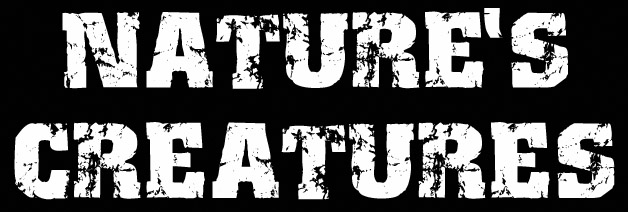

I'm unsure what the bottom translates as. Can a Dutch speaker out there email us and let us know? It is: 'Daar hebben wij Joden en Marxisten genoeg voor!']


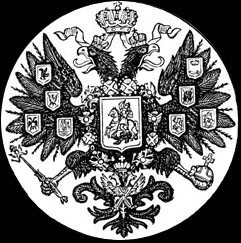

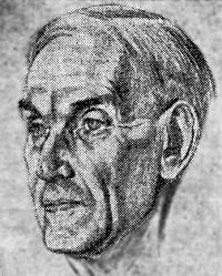


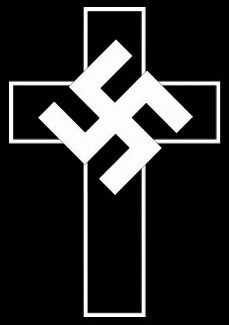
-Jesus Christ, John 15:18
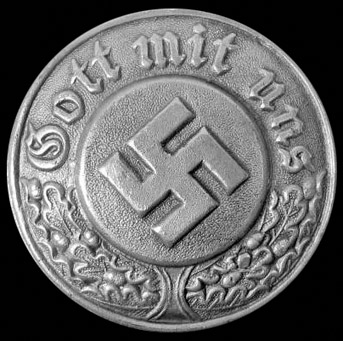
'I swear by God this holy oath, to the Führer of the German Reich and people...'
]
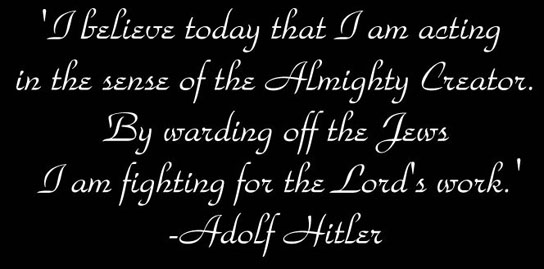
destroyed most of the Christian churches in Russia and Ukraine,
about 2500 churches were built in Germany.
NOT ONE Christian church was closed.'
-Living in Hitler's Germany, A letter from Hans Schmidt of GANPAC, published by the Hoskins Report, December 1993.
Schimdt had grown up in National Socialist Germany and was a member of the Hitler Youth.
'We demand freedom of religion for all religious denominations within the state so long as they do not endanger its existence or oppose the moral senses of the Germanic race. The Party as such advocates the standpoint of a positive Christianity without binding itself confessionally to any one denomination. It combats the Jewish-materialistic spirit within and around us and is convinced that a lasting recovery of our nation can only succeed from within on the framework: The common good before the individual good.'
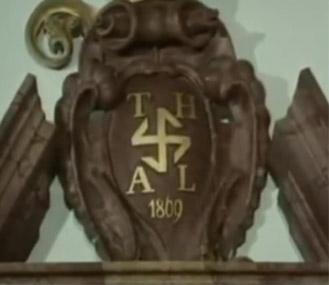
He believed deeply in God. He called God the Almighty, master of all that is known and unknown.
Propagandists portrayed Hitler as an atheist. He was not.'
[page 29]
the Government is creating and securing the conditions for a really deep and
inner religious life. The advantages for the individual which may be derived
from compromises with atheistic organizations do not compare in any way
with the consequences which are visible in the destruction of our common
religious and ethical values.
justice. It cannot, however, tolerate allowing membership of a certain
denomination or of a certain race being used as a release from all common legal
obligations, or as a blank check for unpunishable behavior, or for the
toleration of crimes. [The national Government will allow and confirm to the
Christian denominations the enjoyment of their due influence in schools and
education.] And it will be concerned for the sincere cooperation between Church and State.
people's community (Volksgemeinschaft) serves as much the interests of the
German nation as of our Christian faith. ...The national Government, seeing in
Christianity the unshakable foundation of the moral and ethical life of our
people, attaches utmost importance to the cultivation and maintenance of the
friendliest relations with the Holy See. ...The rights of the churches will not
be curtailed; their position in relation to the State will not be changed.'
either to the Reich Representative of the State concerned, or to the President of the
Reich, according to the following formula:
loyalty to the German Reich and to the State of [land]... I swear and promise to
honor the legally constituted Government and to cause the clergy of my diocese to honor
it. In the performance of my spiritual office and in my solicitude for the welfare and
the interests of the German Reich, I will endeavor to avoid all detrimental acts which
might endanger it."'
reveal here, I must say that I found, despite everything, a greater tolerance
with regard to the new government. ...Let us meditate on the words of the
Holy Father, who in a consistory, without mentioning his name, indicated
before the whole world in Adolf Hitler the statesmen who first, after the Pope
himself, has raised his voice against Bolshevism.'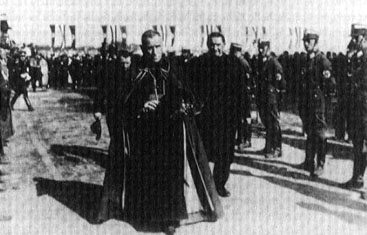
-Pope Pius XII (Church of Spies, Mark Riebling, pg.11)

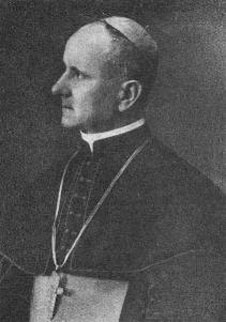
And they were deaf. Now God has decided to use other methods.
He will prepare missions! World missions!
They will be upheld not by priests but by army commanders led by Hitler.
The sermons will be heard with the help of cannon, machine guns, tanks and bombers.'
-Pitar Pajic, as published in the diocesan newspaper of Ivan Šaric, archbishop of the Roman Catholic Archdiocese of Vrhbosna (Sarajevo).
who crucified him and immediately persecuted his disciples,
are guilty of greater excesses than those of their forefathers. Greed is growing.
The Jews who led Europe and the entire world to disaster - morally, culturally and economically - developed
an appetite which nothing less than the world as a whole could satisfy... Love has its limits.
The movement for freeing the world from Jews is a movement for the renaissance of human dignity.
The all-wise and Almighty God is behind this movement.'
-Father Franjo Kralik, 'Love Has Its Limits', published in Sarajevo in archbishop Ivan Šaric's diocesan newspaper.



It is therefore understandable that words cannot be found to lament over his death, when so many were found to exalt his life.
Over his mortal remains stands his victorious moral figure.
With the palm of the martyr, God gives Hitler the laurels of victory'.
-Francisco Franco


It says 'Help fight against hunger and cold.' and at the bottom 'Sacrifice'.]
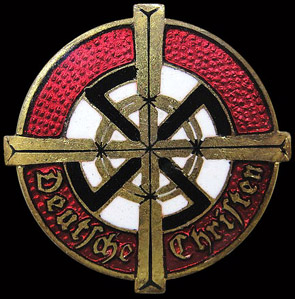
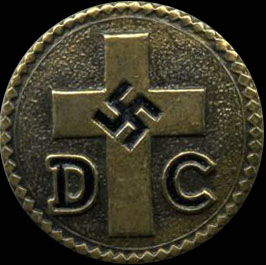
It became reality in the person of Adolf Hitler and the Nationalist State molded by him.'
-The third tenet or law of the Guidelines for the Spiritual Movement of German Christians, Thuringia, December 11, 1933.

-Slogan of the German Christians party
-Hans Kerrl, Reich Minister for Church Affairs, February 13, 1937
A lasting peace can only be achieved by replacement or dismissal of all clergy who are not able or willing to
participate in the completion of the reform of renewal of our people in the spirit of National Socialism.'
- 1st 'Resolution by the Religious Movement of German Christians'
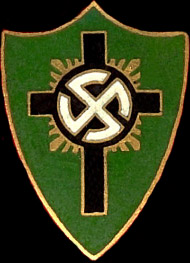
'[the] Party as such advocates the standpoint of a positive Christianity without binding itself confessionally to any one denomination.
It combats the Jewish-materialistic spirit within and around us'.

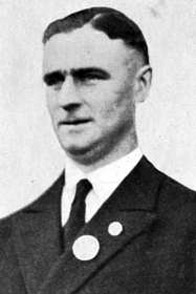
-Julius Leutheuser
-Julius Leutheuser, 'Die deutsche Christusgemeinde'
-Julius Leutheuser
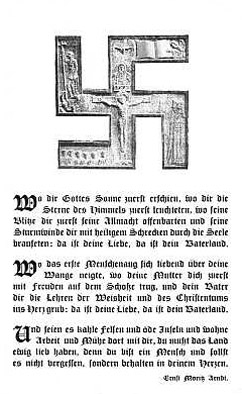

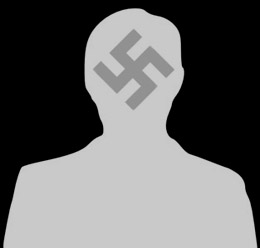
-Pastor Siegfried Leffler, 'Christus im Drittem Reich der Deutschen', p. 13-18
-Pastor Siegfried Leffler

'The Swastika on our breasts, the Cross in our hearts.'
-German Christians motto
The two, Bishop Joachim Hossenfelder and Dr. Friederich Werner, the cabinet's legal counselor, took the broad hint of the minister of the interior that their aggressive policy of dragging politics into the church and tolerating 'flagrant heretics' threatened to wreck the Evangelical Church.
Both have been accused of ousting Jews from Protestant church offices, condoning the recommendations of some Hitlerite German Christians that the Old Testament be eliminated and the New revised, and of creating Nazi-controlled authority.
Bishop Hossenfelder particularly had been under fire for weeks as the Nazi churchman and their more conservative opponents engaged in an increasingly heated controversy over Semitism, leadership, the suspension of dissident pastors, and suggested Scriptural and dogma changes.
Simultaneously the announcement was made of the indefinite postponement from Dec. 3 of the consecration of Dr. Ludwig Mueller.'
-The Cornell Daily Sun, Volume 54, Number 57, November 29, 1933

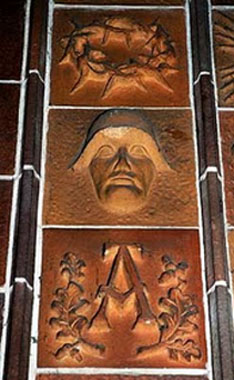
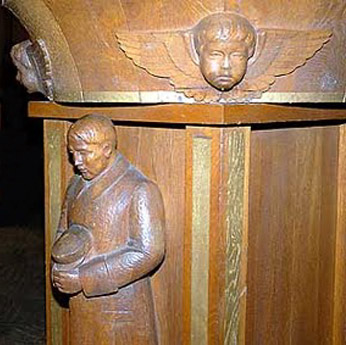
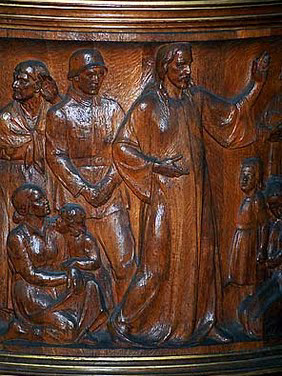
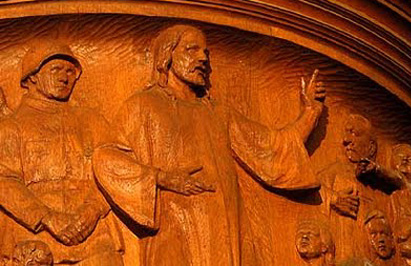
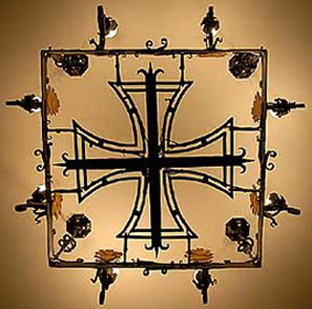
will rid itself of all that is not German in liturgy and confessions,
especially as described in the Old Testament and its Jewish monetary morals.'
- 4th 'Resolution by the Religious Movement of German Christians'


'We would still go on with the Führer even if he closed the church doors before us. In Germany, there is no life except with the Führer... The present-day task of theological science is to provide a religious foundation for the new State ethics.'
'Martin Luther and the Jews'
(click image below):
'Hitlers Kampf und Luthers Lehr
Des deutschen Volkes gute Wehr'
basically translates as
'Hitler's struggle and Luther's teaching
A good defense for the German people' ]

[The Aryan Jesus: Christian Theologians
and the Bible in Nazi Germany by Susannah Heschel]
'Under the title "The Message of God" a version of the New Testament was published in 1940, which had been prepared by the "Institute for the Study and Elimination of Jewish influence on German church life". It was to serve as a basis for the renewal of a "German national church" in the spirit of German Christians. In its first part, the 'Message of God' provides a 'gospel harmony', that is, an ongoing summary of the life of Jesus made essentially from the Synoptic Gospels. A significant feature of this treatment is the systematic removal of specific Jewish expressions and ideas, but also central references to the Old Testament. The scientific director of the institute was Walter Grundmann, professor of the New Testament at the Faculty of Theology in Jena. In the years after 1945 Grundmann has published a comprehensive presentation of Jesus as well as scientific commentary on the three Synoptics. The seminar will investigate if and how the interpretive principles of the 'message of God' have also been reflected in Grundmann's works after 1945.'
'We baptize you that you may be consecrated and brave in life, faithfully committed to the Volk in a new time in truth'.
'Jesus of Nazareth in the Galilee proves in his
message and behavior a spirit that is in opposition
to Judaism in every way. The struggle between him
and the Jew became so bitter that it led to his deadly
crucifixion. Thus Jesus cannot have been a Jew.
Until this very day the Jews persecute Jesus and
all who follow him with irreconcilable hatred.'

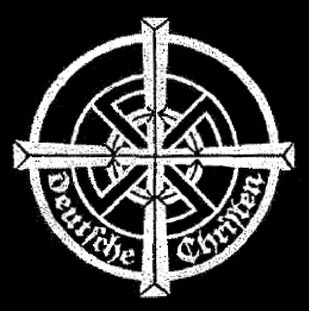

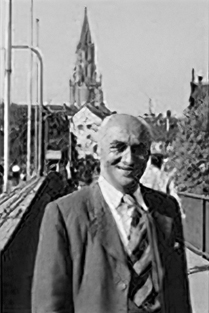
The holy places of Palestine must not be visited, but instead those of Germany.
In the German Church, men of alien blood have no place — either on or under the pulpit...'
'That we must demand a return to the heroic Jesus whose life was an example to us and whose death is a seal upon a life of heroism and struggle. We must be careful, however, not to exaggerate the Christ crucified'."
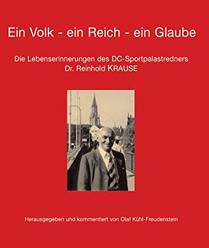

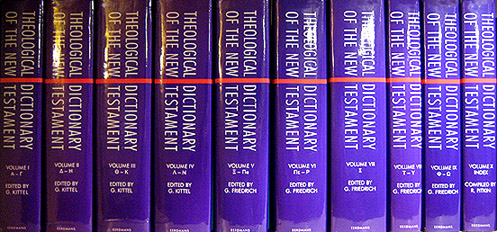
-German Lutheran theologian Paul Althaus, considered to be one of the foremost experts of Martin Luther's theology.
-Dean of the Magdeburg Cathedral
'Err segne unser kampf!
Adolf Hitler.'
=
'God bless our struggle!'
Adolf Hitler.]
21. Mai - 25. September 1934
1634 - 1934
Deutschland ruft Euch!'
May 21 - September 25, 1934
1634 - 1934
Germany calls you!)
-the 'Ansbacher Ratschlag', a document [p. 145] signed in 1934 by eight theologians led by a priest named Hans Sommerer who led a theological work group within the National Socialist Evangelical Pastoral Union (NSEP).
'…the holder of the Mother's Cross of Honor will in the future enjoy all types of privileges that we by nature have accustomed to our nation's honored comrades and our injured war veterans.]
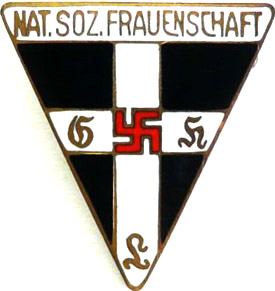

'Our Frauenschaft flag carries the same colors as the Swastika flag, with our flag black stands out, solemn and worthy.
On top shine forth the Christian cross in the color of purity, constantly warning us:
"You women and mothers, be real Christians; protect Christianity in your family, rear your children to love the savior."'

-Adolf Hitler, Berlin speech, January 30, 1942
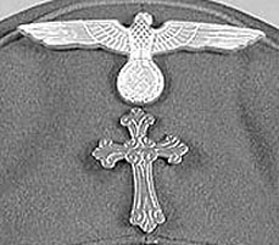
'I vow to you, Adolf Hitler, as Führer and chancellor of the German Reich loyalty and bravery. I vow to you and to the leaders that you set for me, absolute allegiance until death. So help me God!'
'Yes, I believe in a Lord God.'
'I think he is arrogant, megalomaniacal and stupid; he is not eligible for us.'
-Joseph Goebbels

--The Holy Reich - Nazi Conceptions of Christianity, 1919-1945, Richard Steigmann-Gall, pg. 131